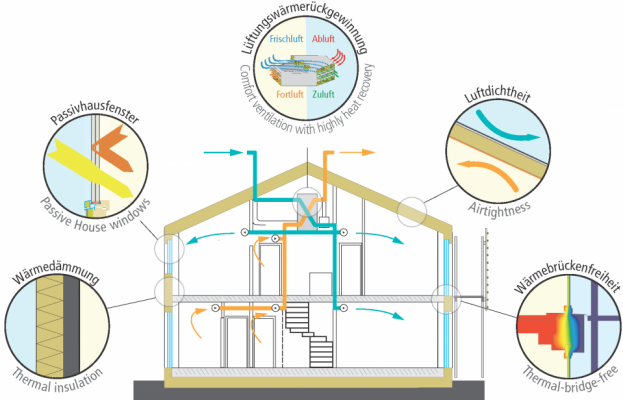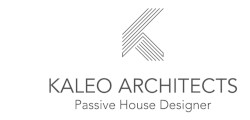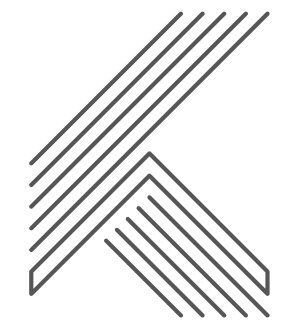
What Is Passive House?
Passive House is a fabric-first approach to building design and construction to achieve healthy, comfortable and energy efficient buildings. The fabric is the building envelop, i.e., the floors, walls and roof of a building. By ensuring that the floors, walls and roofs are designed and detailed correctly provides for a high-performance thermal envelope that will maintain indoor temperature at comfortable levels for most of the year.
In most conventional buildings, it is high energy systems and technology that keeps a house thermally comfortable. In a Passive House, it is the building fabric that keeps the house comfortable.
Passive House is both a set of principles and a performance standard for energy efficient buildings. It is not a specific construction method. The Passive House standard was developed by the Passive House Institute in Germany. The standard is first and foremost about occupant comfort. It seeks to produce high quality indoor environments with the use of the least amount of energy.
KEY PRINCIPLES OF PASSIVE HOUSE
The Passive House standard is built around 5 key principles

Principle 1
Super Levels of Thermal Insulation
Thermal insulation is a key component to achieving Passive House. Just as an insulated vacuum flask keeps drinks at the desired temperature, super high levels of thermal insulation to the building fabric will keep indoor areas at a pleasant temperature and will substantially reduce heat loss in winter and heat gain in summer.
Principle 2
Thermal-Bridge-Free Construction
Building envelopes not only consist of walls, roofs and ceilings but also corners, edges, connections and penetrations. Much energy can pass through these areas where the thermal envelope is broken or compromised. This is known as thermal bridging. It can cause substantial heat loss leading to cold patches that could cause condensation and mould growth. Hence, it is very important that the super levels of thermal insulation layer is applied continuously around the entire building envelope without being thermally bridged.
Principle 3
Airtight Construction
Airtightness of the building envelope is required to prevent heat loss through air leakages through the building and allow for controlled ventilation strategies to reduce draughts and noise. It also prevents moist air from condensing on the building fabric which could affect the durability of the building structure.
Principle 4
High Performance Windows and Doors
High quality windows and doors with double or even triple glazing with insulated frames and insulated spacers between glazing are used to maintain the thermal performance of the glass.
Principle 5
Controlled Mechanical Ventilation with Heat Recovery
The Passive House principles incorporates an extremely energy efficient mechanical ventilation with heat recovery system into the overall design of the building. This system brings in fresh air from the outside and exhaust out stale air from the inside. The heat recovery function, as the name suggests, recovers heat from the stale air before it is exhausted out and uses this heat to warm the incoming fresh air. Hence, a high level of indoor air quality is maintained throughout the building with minimum use of energy.
The ventilation system used for a Passive House must have a heat recovery efficiency of at least 75% while the electricity consumption should not exceed 0.45 Wh/m³ of the transport air volume. Additionally, the acoustic load of the system should not exceed 25dB.
PASSIVE HOUSE PERFORMANCE CRITERIA
The Passive House standard has clear set performance criteria and a great quality assurance process via certification to ensure that these criteria are meet. The building design must meet the following criteria:
 Space heating demand
Space heating demand
Not to exceed 15 kWh annually OR 10W (peak demand) per square metre of usable living space
![]() Space cooling demand
Space cooling demand
Not to exceed 15 kWh annually OR 10W (peak demand) per square metre of usable living space plus climate-dependent allowance for dehumidification
![]() Primary energy demand
Primary energy demand
Not to exceed 120 kWh annually for all domestic applications (heating, cooling, hot water, and domestic electricity) per square metre of usable living space
![]() Airtightness
Airtightness
Maximum of 0.6 air changes per hour at 50 Pascals pressure (as verified with an onsite pressure test in both pressurised and depressurised states)
![]() Thermal Comfort
Thermal Comfort
Must be met for all living areas year-round with not more than 10% of the hours in any given year over 25℃
WHY PASSIVE HOUSE
There are many reasons and benefits to build a Passive House. These include:
Thermal Comfort
A Passive House maintains a stable, even and comfortable temperature throughout the entire building all year round, free from draughts, free from cold spots and free from excessive overheating.
Healthy & Quiet
Passive House buildings provide a healthy and quiet indoor environment. As we now spend such a significant period of our time indoors, the buildings we live in clearly have an impact on our health and wellbeing. The ventilation systems installed in Passive House buildings provide a constant supply of fresh air, ensuring pollutants and odours are removed from the building whilst maintaining a comfortable indoor air temperature. The high-performance insulation and windows installed in Passive House buildings also make such buildings extremely quiet. If your building is located in a busy urban area, you will be protected from noise and pollution so that you can enjoy peacefully being in your workplace or living in your home.
Energy Efficiency
Passive House buildings are designed and constructed to be highly energy efficient. The vigorous planning procedures and calculations performed with the use of the Passive House Planning Package software ensures that there is no performance gap between the expected and actual building performance. For the owner and occupants, this means a significant reduction in energy bills because of considerable reduction in energy consumption for heating and cooling. As an indication, here is a diagram showing the energy usage for heating in a Passive House compares compared to a low energy house. The Passive House Institute has been found savings to be over 75% annually. If compared to a conventional house that just meets regulation requirements for energy efficiency, the savings could be even as high as 90%.
Quality Build
A Passive House is built to last. The fabric-first approach with sound building physics results in superior construction, detailing and workmanship.
Performance Assured
The design, construction and certification process required for a Passive House ensures that the finished building performs as expected.
Sustainable
An ultra-low energy use or near net-zero energy building leads to reductions in carbon emissions and minimise use of limited resources such as gas and oil.
Value on Investment
Passive House buildings represent a long lasting, valuable investment for owners, occupiers, developers and investors. The Passive House approach focuses on allocating funds into a high performance building fabric which has a long life-cycle instead of add-on technologies which has a much shorter life-cycle.
Reliable
Whilst relatively new in Australia, Passive House was developed in the 1990s by Dr Wolfgang Feist who established the Passive House Institute in Germany. Since then Passive House has gained popularity and has proven to be a reliable approach in an ever-increasing range of climates. Tens of thousands of Passive House buildings have been built worldwide and have performed outstandingly in use. Of these, several hundred have been empirically monitored and rigorously tested by the Passive House Institute. The results have been consistently positive.
Resilient to Change
A Passive House will be more resilient to the impact of climate change and will stay comfortable and habitable for much longer than conventional buildings in cast of power outrage.
Uncomplicated
No user manuals or complicated technology is need to operate a Passive House. Built into the design of a Passive House is user-friendliness.
Access to finance
Passive House Certified Buildings qualify for reduced interest rates on borrowing.
More information here – https://www.bankaust.com.au/personal/borrow/home-loans/clean-energy-home-loan/


